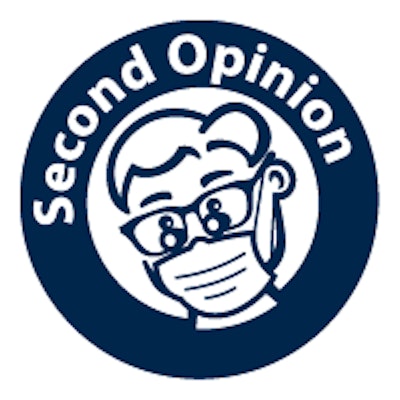
The word "dentistry" is a misnomer. Despite the confines intrinsic to the word itself, our practice extends beyond the diagnosis and treatment of diseases of the teeth. Dentistry is in fact a medical specialty. We are trained in the diagnosis and treatment of a specific region of the body.
Consider what we do on a typical day in our practice. We examine the entire oral cavity and the surrounding head and neck area. We screen our patients visually for oral cancer and radiographically for maxillofacial cancer. We evaluate and treat functional problems of the temporomandibular joint. We diagnose and correct deformities, deficiencies, and disease processes in the bones of the face. We screen our patients for signs of sleep disordered breathing, and we construct appliances that treat obstructive sleep apnea.
Our examinations are not limited to the dentition. A portion of our daily practice is dental in nature and part of it is medical in nature. The medical part of our practice is that part which is beyond the teeth. Systemic medical conditions manifest themselves in the oral cavity. Overlooking or ignoring the medical portion of our practices prevents us from being compensated for the medical aspect of what we do every day in our practices.
Billing
Medical billing is a key part of the modern dental practice. We do not limit our practice to teeth, and we should not limit our insurance reimbursement to just dental insurance. Doing so is a disservice to our patients and our practice. Dental insurance annual benefits are minimal and have not significantly increased since its inception. These paltry benefits are best left for the treatment of the teeth.
 Chris Farrugia, DDS.
Chris Farrugia, DDS.Meanwhile, medicine is changing. Those changes will find their way into our specialty. In 2012, the ADA altered the dental claim form to require diagnosis codes and include diagnosis pointers, both of which are integral parts of the medical claim form. The divides between dentistry and medicine and between dental insurance and medical insurance are narrowing. This is an opportunity to step back, consider the coming changes, and make decisions about the future of our practices that position them for success in both the short and long term.
Dentistry also is changing. Technology allows us to see and do things that were unimaginable and unattainable five to 10 years ago. With change comes an evolution in the standard of care applied to our practice.
Computed tomography (CT) has become that standard for imaging patients in clinical situations we deal with regularly.
A statement was prepared by the Special Committee to Revise the Joint American Association of Endodontists (AAE)/American Academy of Oral and Maxillofacial Radiology (AAOMR) Position on Cone Beam Computed Tomography, and it was approved by the AAE Board of Directors and AAOMR Executive Council in May 2015.
CT should be considered the imaging modality of choice for diagnosing patients who present with contradictory or nonspecific clinical signs and symptoms that are associated with any of the following:
- Untreated or previously endodontically treated teeth
- Initial treatment of teeth with the potential for extra canals and suspected complex morphology
- Intra-appointment identification and localization of calcified canals
- Evaluating the nonhealing of previously endodontically treated teeth
- Nonsurgical retreatment to assess endodontic treatment complications
- Presurgical treatment planning to localize root apex/apices and to evaluate the proximity to adjacent anatomical structures
- Surgical placement of implants
- Diagnosis and management of limited dentoalveolar trauma, root fractures, luxation, or displacement of teeth and localized alveolar fractures
- Localization and differentiation of external and internal resorptive defects
General dentists are held to the same standard of care as specialists diagnosing and treating the same conditions.
Practice experience
The addition of CT technology to my practice led me to medical billing. A CT system is an expensive piece of equipment. I wanted the increased diagnostic capabilities that CT provides to clinicians, but I needed to know how to pay for it.
I purchased the system on faith that it would "pay for itself," but I had no idea how that would actually happen. I had heard whispers that CT services could be paid by medical insurance, but first I had to learn how to file medical claims to be reimbursed.
It turns out that medical billing had a profound effect on my practice. In addition to learning how to bill medical insurance for CT, I learned that medical insurance will cover a range of services our profession provides. I was reminded that dentistry is a medical specialty. I began to clearly see which part of my practice is dental and which part of my practice is medical.
Understanding that concept and applying it to the systems in my practice allowed me to succeed in obtaining medical insurance benefits for the medical aspect of what we do in our practices. My practice ceased being a dental practice and instead became a medical-style practice that treats teeth.
The effects of this transformation are real and measurable. While fee revenue from medical insurance is easily quantified, my practice enjoys other benefits from this paradigm shift. Any dollar paid by medical insurance toward the fee charged for services rendered in turn reduces my patients' out-of-pocket expense. Receiving medical benefits before filing a dental insurance claim saves my patients' dental benefits for treatment of their teeth.
For instance, a patient that requires an exam, orthopantogram, and CT scan that are covered by and paid by medical insurance would still have dental benefits available when they break a tooth -- which would require a dental procedure such as a crown -- in the same year. Plus, my practice's position as a medical-style business that treats teeth differentiates my practice from other "traditional" dental practices in my area.
The only barriers along this path are fear and lack of knowledge: the imagined fear that dentists are not allowed to bill medical insurance, or the fear that it is difficult to do.
Insurance is a contract that has benefits payable when the conditions of the contract are met. In that regard, medical insurance is no different than dental insurance. Certainly, the rules for medical insurance claims are slightly different than what we are accustomed to with dental claims. Once you gain the knowledge of these rules, navigating the path to payment by medical insurance becomes routine.
Perhaps the biggest obstacle is our own thought process. Dentistry defines itself through the prism of teeth; only after freeing yourself from that limited view is it possible to expand the revenue source available to your practice. As a licensed healthcare provider practicing within the scope of your license, you are entitled to do so.
Our practices are filled with patients who pay premiums every month for medical insurance policies that have benefits payable for services we render. Now that you know that, how will you apply that knowledge?
Chris Farrugia, DDS, practices dentistry in northwest Florida. He teaches medical billing courses around the U.S. Find his schedule at www.successfulmedicalbilling.com, and contact him at [email protected].
The comments and observations expressed herein do not necessarily reflect the opinions of DrBicuspid.com, nor should they be construed as an endorsement or admonishment of any particular idea, vendor, or organization.


















